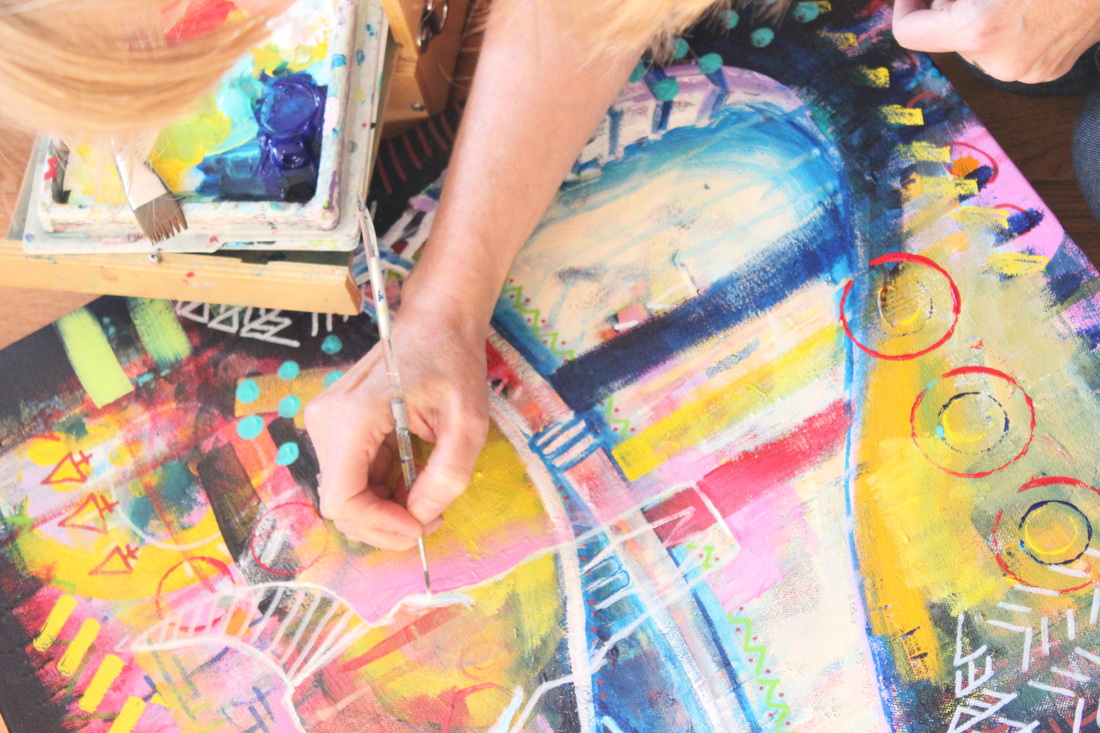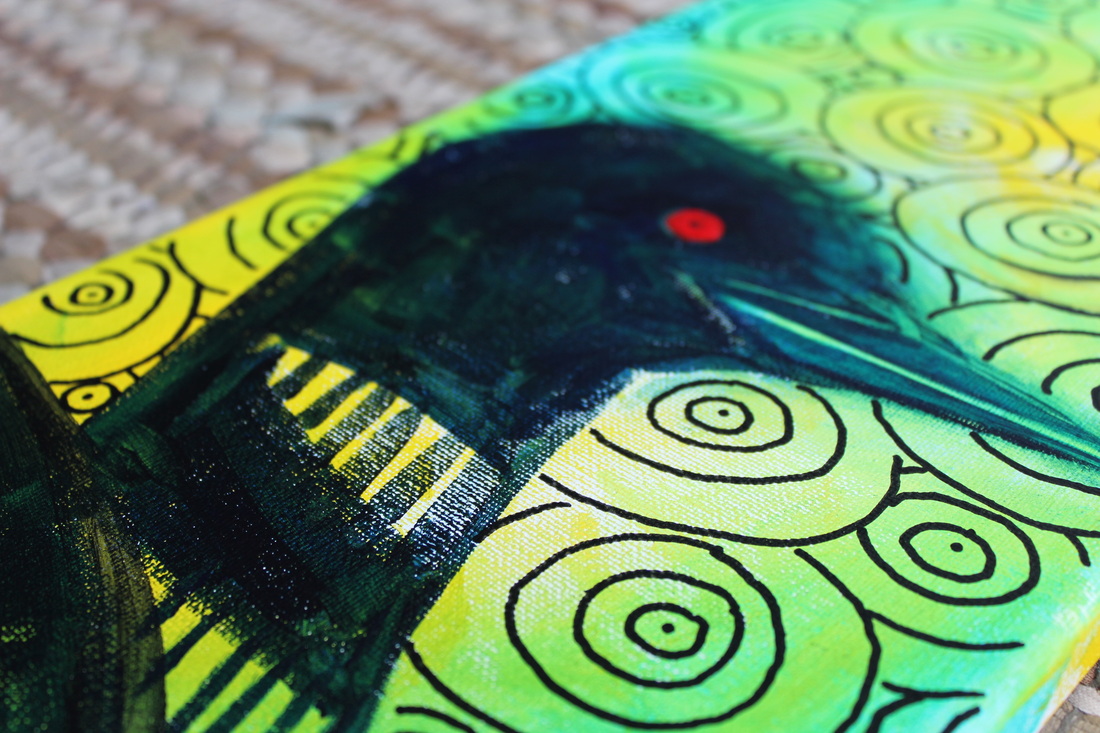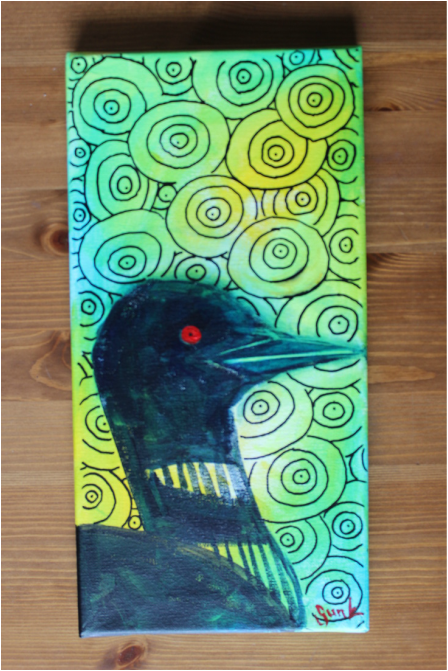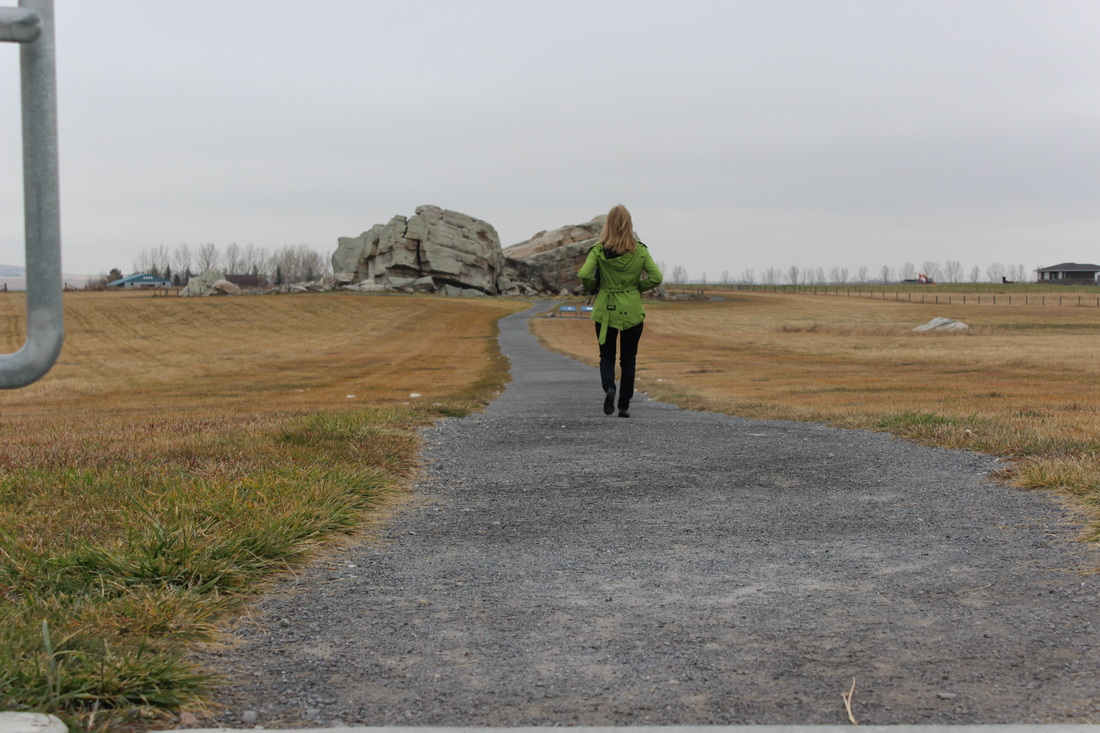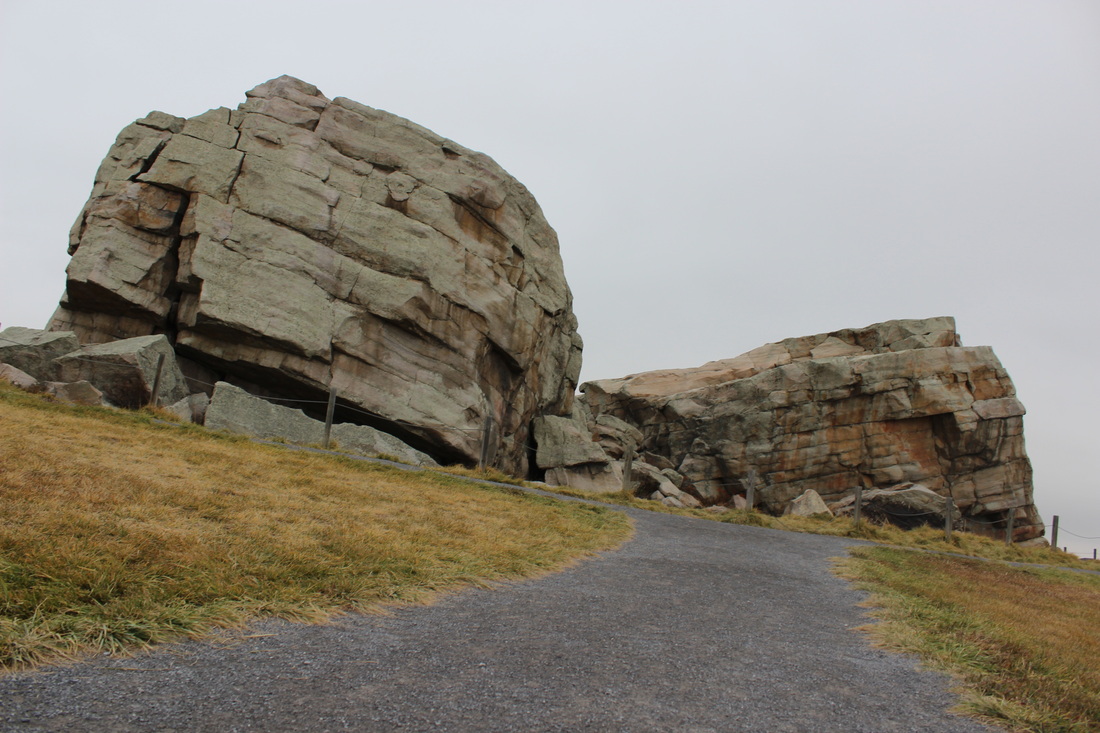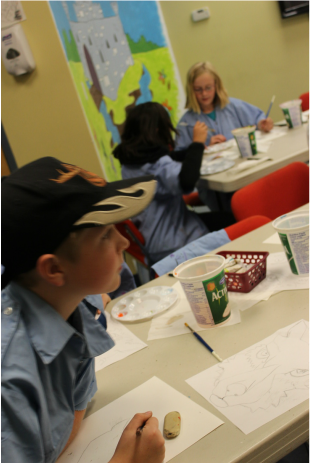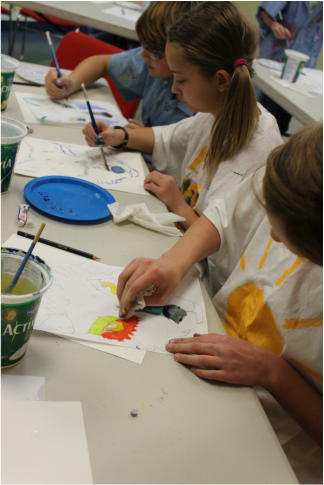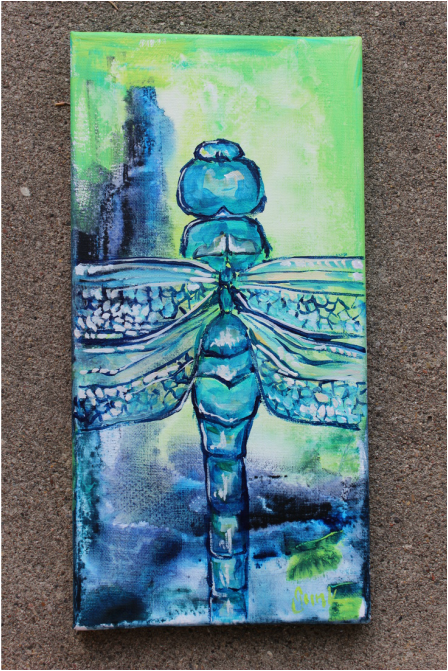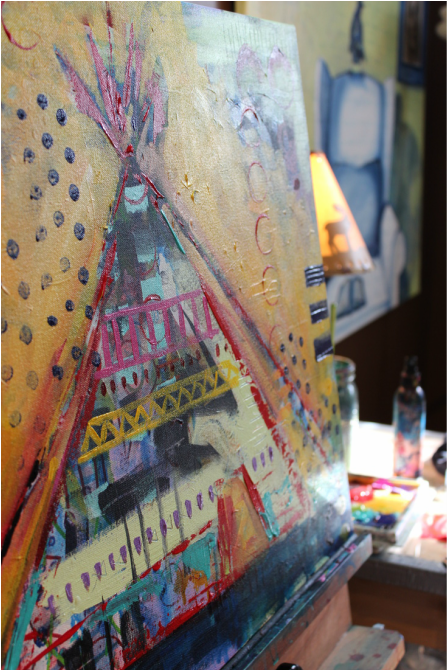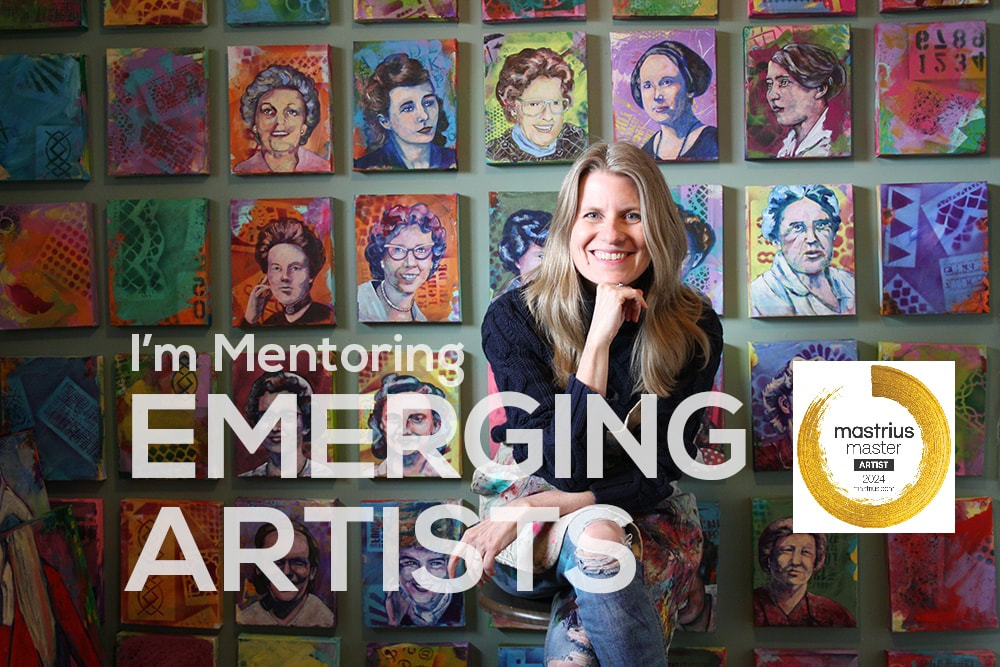|
When I was in art college we practiced a variety of interesting exercises to loosen up and use our entire bodies when we were creating and others to help us to see and draw better. I like to use them when I work with kids as they always have fun with it, but it is also good for me, not only to loosen up but also to trust myself a little more when I work...it also helps the old hand-eye coordination which is vital as an artist.
1. Draw Eggs Our profs often told us if we could draw an egg realistically, including all the values of highlights, shading, shadows, cast shadows and reflected light, then we could draw anything. It's really not as easy as it sounds. 2. BIG! We would often tape 4 large sheets of newsprint together and, with charcoal or paint, we would crawl around the paper and using our whole arm & body we would draw or paint. Lots of eggs, but flowers, fabric and skeletons, too. 3. Left Hand Or right if you are left-handed. This allows you to focus on the object you are drawing rather than on repeating patterns from your past. The piece above (yes, eggs) was painted with my non-dominant hand in gouache and is the only piece I have left from school (my final portfolio was stolen...which was actually a compliment). 4. Switch If you work with other artists, sometimes it's a good idea to set up a still life and work for 10 minutes, then switch with your partner (or if more than one, move from piece to piece) for two reasons. The first is to gain a different perspective of the object to help you understand the form more fully and the second is that it forces you to work in a slightly different manner based on someone else's beginning. 5. Contour There are two ways of performing contour drawing, one is by looking at an object and then only drawing its outline (contour) while being able to look at the paper...the second is blind contour, so no looking at the paper. In both cases do not lift your pen/pencil from the page. It's a great exercise to see how the form (positive space) interacts with the negative space around it. 6. Self-portrait This is one form of creativity that has been practiced by artists throughout time. It's best to use a mirror and draw, paint, collage, etc. A great way to learn that everything is made up of shapes and how different shapes interact with one another as well as how much space there is between each shape. 7. Mirror Image One of the neatest tricks I learned was to turn my work to a mirror. There is something about a new perspective that helps to see the problem areas. I find it works well with colour as well...to see those parts that aren't working cohesively. 8. Shade First This one is interesting...shade in your image before adding the drawing lines. Certainly helps to push the boundaries a little more and forces you to pay attention how the shapes of your object sit in proportion to one another. 9. Don't Look Look at an item intensely for fifteen minutes and then turn away from it to draw (or paint) it. When you're stuck close your eyes and envision it. It's interesting to see how much we can remember if we really pay attention. 10. Draw EVERY Day It doesn't matter what you draw, the physical act of drawing is important. You'll improve your hand-eye coordination, your shapes, values, lines, proportion, perspective and composition...all the basic elements of design. Last week I dropped off some of my tiny tipis at Bluerock Gallery (you can see them on the far left near the lamp) while the weather was still absolutely gorgeous. And then, on Sunday, we were hit with a heavy, wet snowfall which meant I got to spend a day on the sofa reading which leads me to a few great reads of late:
The Book of Salt by Monique Truong This was an interesting story set in 1930s Paris in the house of Gertrude Stein and Alice B Toklas and told from the perspective of their Vietnamese cook Binh. I was looking forward to read about Stein and Toklas and their many admirers but found that I became attached to Binh and his story. He had many obstacles to overcome, from his childhood in an unhappy home in Saigon to his struggle to be fully himself as an adult. Many times people took advantage of him and yet he remained positive, overcoming the challenges he faced. The Lace Reader by Brunonia Barry I had stumbled upon this book and was fascinated by this story from the moment I viewed the cover and read the book description and was not disappointed. The novel centers around a family of women in Salem who have the gift of reading lace. The story is filled with handwork, magic, witches and mystery with a difficult family history. Always a perfect combination. Absolutely riveting! Whistling Past the Graveyard by Susan Crandall When I first heard of this novel I was reminded of 'The Secret Life of Bees' but as I read I became totally engrossed in the story of the main character, nine-year-old Starla Claudelle. This story takes place in the early 1960's, during a time of great upheaval in the deep south. Starla is a passionate red-haired young girl who cannot help but speak up for those in need, often using her fists, and ends up running away from her grandmother's home in order to find the mother who left her long ago. She is picked up by Eula, a black woman traveling with a white baby, and they face many trials on the road together. Putting the finishing touches on the final piece for Ayrspace Gallery in Ontario. By tomorrow the work should be on its merry way to Ontario. So excited!
It's always interesting to me how the process of painting tends to resemble a love/hate relationship. Beginning can be intimidating when I am facing a blank canvas...and then I add colour which looks stunning against the white. Then I add more colour and I begin to question my colour selection...but by layer number three or four I begin to love it again. And then I add the image and question the choice I've made...and begin adding more colour and once again I'm in love. But I begin to feel that I'm hiding too much of the original pattern that I enjoyed adding so much, so I add in more once again. And then I'm uncertain and hide some more, and add some more until I begin to fall in love again. It's at this point that I begin to feel that the work is complete. I really do love the work...the entire process. And I've learned to appreciate the love/hate part of the process, too. It's during these times that I know wherein lies great inspiration. This is the point where I have learned not to give up. I think much of life is very much this way...the times I feel absolutely horrible in the pit of my stomach usually precede great moments and huge break-throughs both personally and creatively for me. I've learned at these times to be patient with myself and to trust and allow whatever needs to happen. Recently I read a psychological account of how every relationship works in this way. Originally in a new friendship, intimate relationship, work environment, education or workshop there is a looking through rose-coloured glasses period which is followed by seeing flaws in every one and every thing. These are often the times we want to give up and yet, in a mature human being, this is a critical time to continue on, to pay attention and have compassion for both ourselves and others, and to blossom. Sometimes it does mean moving on...both personally and creatively...and at other times it means digging in and working harder...to quote Winston Churchill, "Never, never, never give up." The fun part is that each of us get to make our own choices. This loon was so much fun to paint, with the graphic nature of the patterns in his plumage. My daughter suggested adding more pattern to the background to suggest the haunting sounds that loons make, which immediately brought to mind echoes and images of rippling water. As I drew the patterns I realized that the patterns also replicated the eye of the loon...perfect.
Loon as totem animal represents hopes, dreams, wishes. They remind us to pay attention to our dreams and awakens our imagination. Loon helps us to remember to look for the truth and that our dreams can become a reality. They are often solitary birds, also symbolizing tranquility and serenity. Legend tells us that to see a loon is to know that a wish will be fulfilled...I do hope yours come true. This piece is now ready to be packaged and shipped for a total of 19 pieces which are heading to ArySpace Gallery in Ontario. I have one more to complete (almost there) and then they're off...2 larger pieces (20x20) and 17 minis (6x6 + 5x7). I decided to name this particular piece 'Forgotten Dreams' for two reasons:
1. I often feel deep regret for the way the aboriginal people were treated and too often still are...do they still remember their dreams? 2. Sometimes we need to be given a sacred space in order to remember our forgotten dreams...do you remember yours? There is a necessity for tradition, for ritual, for remembering. Several years ago I had almost given up on this life as an artist until I remembered why I wanted to do this. It wasn't for the recognition or the money, though those are both wonderful bonuses, but rather for the sense of peace and pleasure I experience every day that I spend in my studio. That pure sense of joy. That sense of knowing that this is what I was created to do. I've also been enjoying using my palette knife as a tool to apply colours and marks. I remember our instructors in College telling us that a palette knife is only to be used to mix paint, not to apply it...and yet, I find it makes the most delicious marks. Sometimes it is fun to be a rebel. I delivered a few tiny tipis to the Bluerock Gallery in Black Diamond. Gosh, I love that place. The people I meet there every time are always extremely interesting and the gallery carries the most beautiful things. It's a favorite place to pick up gifts.
Whenever I travel to Black Diamond I have to stop at the Okotoks Erratic, (okotok means 'big rock' in the Blackfoot language) the big rock that Big Rock Brewery was named after. This rock has been such an inspiration for me as it is this massive quartzite that has been plunked into the middle of a field bare of trees during the ice age and is the world's largest glacial erratic. I wish I could convey the sheer size of it. The pictographs on it has inspired much of the mark-making in my work and there is definitely something sacred about being near it. Just knowing it has been here for over 10,000 years and was used as a tool for communication by Indigenous Peoples makes it feel very special. This is the Blackfoot story of how the rock split in half: One hot summer day, Napi, the supernatural trickster of the Blackfoot peoples, rested on the rock because the day was warm and he was tired. He spread his robe on the rock, telling the rock to keep the robe in return for letting Napi rest there. Suddenly, the weather changed and Napi became cold as the wind whistled and the rain fell. Napi asked the rock to return his robe, but the rock refused. Napi got mad and just took the clothing. As he strolled away, he heard a loud noise and turning, he saw the rock was rolling after him. Napi ran for his life. The deer, the bison and the pronghorn were Napi's friends, and they tried to stop the rock by running in front of it. The rock rolled over them. Napi's last chance was to call on the bats for help. Fortunately, they did better than their hoofed neighbours, and by diving at the rock and colliding with it, one of them finally hit the rock just right and it broke into two pieces. Today I had the great honour of delivering paintings to two beautiful young ladies, Monroe & Foster in High River who lost all their personal belongings during the flood in High River this past spring. Such a pleasure to be able to return a little of what they lost. Their home was located near the highway in the highest spot of the community and yet they were still affected greatly by the raging river.
I haven't been to High River since the flood and was saddened to see so many homes and businesses still boarded up and gutted. Beautiful old buildings in the heart of town are still undergoing major renovations and many residents are still homeless. My family moved to Alberta the year after the Manitoba flood seventeen years ago and I know that there are still people who have never recovered a portion of what they lost. I hope that we continue to remember High River and help however we can...by visiting the town and supporting businesses and by contributing financially, through such initiatives as the High River Rotary Club, Project Christmas Hope for High River (www.facebook.com/projectchristmashope or call 403-603-0849) and also by contributing funds for gift cards for Southcenter Mall for those kids who have lost everything (call 403-818-3184). On Saturday I had the great privilege of teaching 15 students how to paint watercolour wolves at the library. Our time passed so quickly as they were engaged and excited about the project, asking questions, sharing stories, trying different things. Then, as I had to travel to the hospital in Lethbridge to see my eldest daughter (emergency appendectomy) they all helped me clean up so I could be on my way quickly. Gosh, what a great group of kids.
Every year that I get to coordinate this program, whether it is bringing artists in to teach or to teach the workshops myself, I feel absolutely grateful. Interacting with children is not only inspiring to me as an artist as I watch them take an idea and make it theirs, but also fulfilling when so many of the art programs have been cut in schools. I'm so glad we offer this program at the library and wish we could offer it for other age groups as well. When I was a girl growing up in the north, we often spent time on the rocky shores of the Churchill River. As my dad would ready the boat for fishing, my brother and I would play along the rocks, looking for those gems, the one that sparkled, whether they were wet or dry. Like everything else up north, the dragonflies were large and would sometimes land on us, at times on my finger. Once I slowly moved the dragonfly closer to my eyes so that I could look closely at his face and I felt a kinship with him and was in awe of the rainbow of colour I saw in his eyes.
I have always been fascinated by their shape, noting that they represent a cross which to me is a symbol of grace. They appear as though they shouldn't be able fly with wings that appear as light as tissue and yet they hover like helicopters, travelling so effortlessly back and forth. As a totem animal, dragonfly teaches us to follow our dreams where we will find our true colours and reflect the light of the Spirit. A great reminder to be who we are meant to be. |
|


